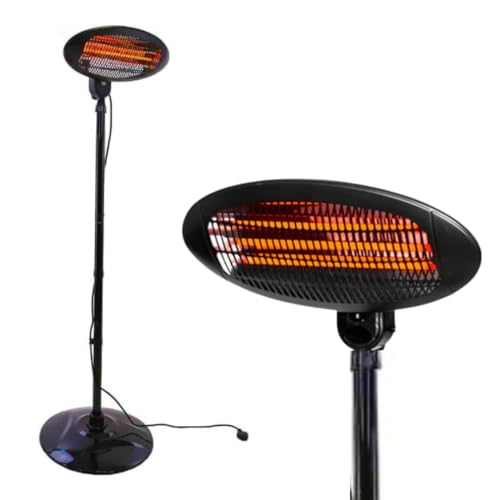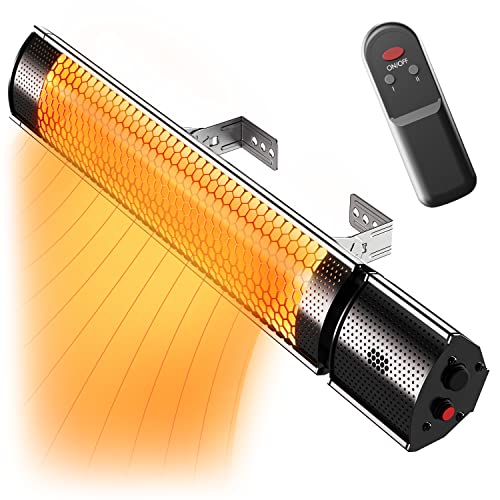9 Lessons Your Parents Teach You About Gas Fire Patio Heater
페이지 정보
작성자 : Antonia
조회수 : 4회
작성일 : 25-02-19 01:17
본문
 gas for patio heater fire patio heater (Discover More)
gas for patio heater fire patio heater (Discover More)A gas fire heater for the patio can warm a seating area and provide an inviting space for socializing. They can be powered by natural gas, propane, or electricity.
 Electric models have the advantage of a lack of fumes or carbon monoxide, however they aren't as mobile as other options. Propane tanks are portable but require refilling and natural gas patio heaters connect directly to the gas line and eliminate the requirement for canisters.
Electric models have the advantage of a lack of fumes or carbon monoxide, however they aren't as mobile as other options. Propane tanks are portable but require refilling and natural gas patio heaters connect directly to the gas line and eliminate the requirement for canisters.Safety Features
Patio heaters can provide a comfortable heat to enjoy your outdoor space. However, they should be used with care. The heaters that emit radiation or are placed close to flammable materials could cause fire hazards, particularly in the conditions of wind. They should be positioned on a level surface and they should be secured or weighted to prevent them from falling over. To prevent accidental contact maintain a minimum distance of 3 feet around the heater. Always follow the manufacturer's instructions regarding setup and operation, and safety guidelines.
The kind of heater you choose will determine the area it will heat, the fuel source, and whether or not it produces radiant heat or a flame. Propane patio heaters utilize propane tanks and are portable, making them ideal for homes and cottages. They also generate a higher amount of heat than other kinds of heaters, however they must be regularly replenished or replaced. Some models come with tilt valves that shut off when they are not in use.
Natural gas patio heaters are connected to the natural gas lines in your home and are a safe alternative to propane. They're also less expensive to operate than propane units, but they are more difficult to relocate. Before you use a natural gas heater, check for leaks by applying a soapy solution to all connections and the gas tank.
Consider an electric patio heater if are worried about the fumes. These units are powered with a plug-in cable and connect to an electrical outlet. They do not produce carbon monoxide or combustion gases. However they're not as efficient and won't warm larger areas as other kinds of heaters.
Outdoor heaters that are decorative come in a variety of styles so you can find the perfect one for your patio. Some heaters are shaped as cylindrical or pillars, whereas others are designed to function as tabletop fireplaces. Some feature decorative covers to keep the burners safe from dust and weather when they are not in use. You can even find hanging units that give a warm glow to the gazebo, pergola, or trellis.
Fuel Sources
The kind of fuel used power a gas fire patio heater determines how it works and how much maintenance is required. It also influences the price of use as well as its environmental impact. There are three kinds of fuel: propane electricity and natural gas. Certain models also use wood too, but they're not suited for restaurants due to the smoke and fire hazards associated with.
Propane patio heaters are fueled by tanks which are positioned inside the base of the unit. This makes heaters mobile and easy to replace if the tank runs out. They are available in the style of the mushroom heaters that are a favorite to patrons of restaurants and pub gardens and also in freestanding units that stand alone, such as a simple fire pit or a fire table that has flames rising from faux logs or lava rocks. Certain models have a long hose to connect to the tank, and others are fitted with specially-designed cannister covers that conceal the hose and nozzle.
People who live in homes tend to prefer propane patio heaters due to the fact that they do not require installation and are more affordable than other gas heating options. They don't provide the same amount of heat as other models, and a 5 gallon tank of propane will only last about 10 hours before it shuts down.
Natural gas heaters function similarly to propane heaters, but provide more consistent heat and BTU levels. They're also more energy-efficient and emit less carbon dioxide than propane models. Natural gas heaters are more expensive and requires a professional installation. It also needs to be connected directly to an existing gas supply, which might not be feasible for businesses who rent or have outdoor seating areas.
Electric patio heaters are more expensive than gas units and require plugging into an outlet. The flameless feature makes them safer to use outdoors but they do require regular maintenance and cleaning. They also have a restricted range of heat they can radiate and may be affected the speed of wind. Before choosing an electric unit make sure you read the manual and local laws to ensure that it is appropriate for your situation.
Adjustability
If you're relaxing on the patio with a cup of coffee or enjoying the family meal You want to enjoy the warm ambience of your outdoor space. A gas fire patio heater can offer warmth and ambience. However, there are a few essential things to know about the use and maintenance of a patio heater in order to prevent issues that could cause injury or injury.
If you're unable to ignite your propane-powered patio heater, you may have a problem with the thermocouple or pilot igniter. The sensor detects flames and then activates gas valves. If the thermocouple or pilot igniter, is blocked by soot and dirt, they will not function correctly. They may also shut off gas flow. Look for obstructions in the pilot igniter or thermocouple and clean it if needed.
Alongside a faulty control knob, the most common reason why a patio heater might not be able to turn on is because the gas tank is empty. Fill the gas tank if it is low before using the heater for your small patio gas. If the problem continues, there could be a leak in the gas pipe that connects to your burner. If it is not addressed immediately the leak in this pipe could cause a fire. A leaky pipe is usually easy to diagnose, as it emits a distinct sound when the gas flows through.
Some patio heaters employ a push-button to light the pilot, and others use an electronic ignition system. In either case, it's an excellent idea to refer to the owner's manual for your particular model and follow the instructions carefully for operation. If you own propane patio heaters ensure that the hose connecting to the tank is properly connected and free of any obstructions that could block the flow of gas.
Both patio heaters and fire pits require regular maintenance and cleaning However, the requirements differ slightly based on the kind of patio heater gas flame heaters you own. A patio heater is less prone to maintenance than a firepit because it is not as exposed to the elements and comes with more safety features.
Installation
To reduce the chance of carbon monoxide or fire, many outdoor heating sources require specific clearances during installation. Make sure that your heater is at least 6 feet away from the ceiling and away from other combustible surfaces such as furniture, trees, and gazeboes. The room must also have open air circulation to avoid the spread of odors and smoke, and you may want to install carbon monoxide detectors to provide additional peace of mind.
A gas fire patio heater is a secure and effective method of adding warmth to a space without occupying valuable floor space or requiring an extensive power source. These heaters have a flexible design that blends into the surrounding environment, so you can pick from a variety of sizes, styles and finishes to match your outdoor decor. Some models are designed to look like traditional fireplaces while others are more contemporary and sleek with fashionable metal finishes.
When choosing a gas-fired patio heater, it is crucial to read the manufacturer's directions carefully. Each kind of heater comes with its own set of safety guidelines, operating instructions and maintenance requirements. The information provided will assist you in deciding if a particular model is right for your needs and also provide you with a thorough idea of what to expect from the device.
Depending on the size and style of your heater, it could require it to be professionally installed. A contractor is charged by the hour, so it's recommended to get an estimate before hiring a pro. The cost of installation will depend on the location of your heater and whether you'll need to run a gas line.
If you are on a budget, you may be able to save money by purchasing propane gas heater that's freestanding or Gas Fire Patio Heater a natural gas heater that connects to your existing gas line. Be aware that you'll be charged by your local gas company based on the amount of BTUs the heater produces.
The investment in a top-quality gas patio heater will bring warmth and ambience to your backyard for many years to come. You'll find a wide variety of options at Lowe's, including portable and freestanding designs which are perfect for smaller spaces. We have high-efficiency, energy-saving models with a heating output of up to 48000 BTU. You can select a dual-fuel model that burns both natural gas and propane for greater versatility.